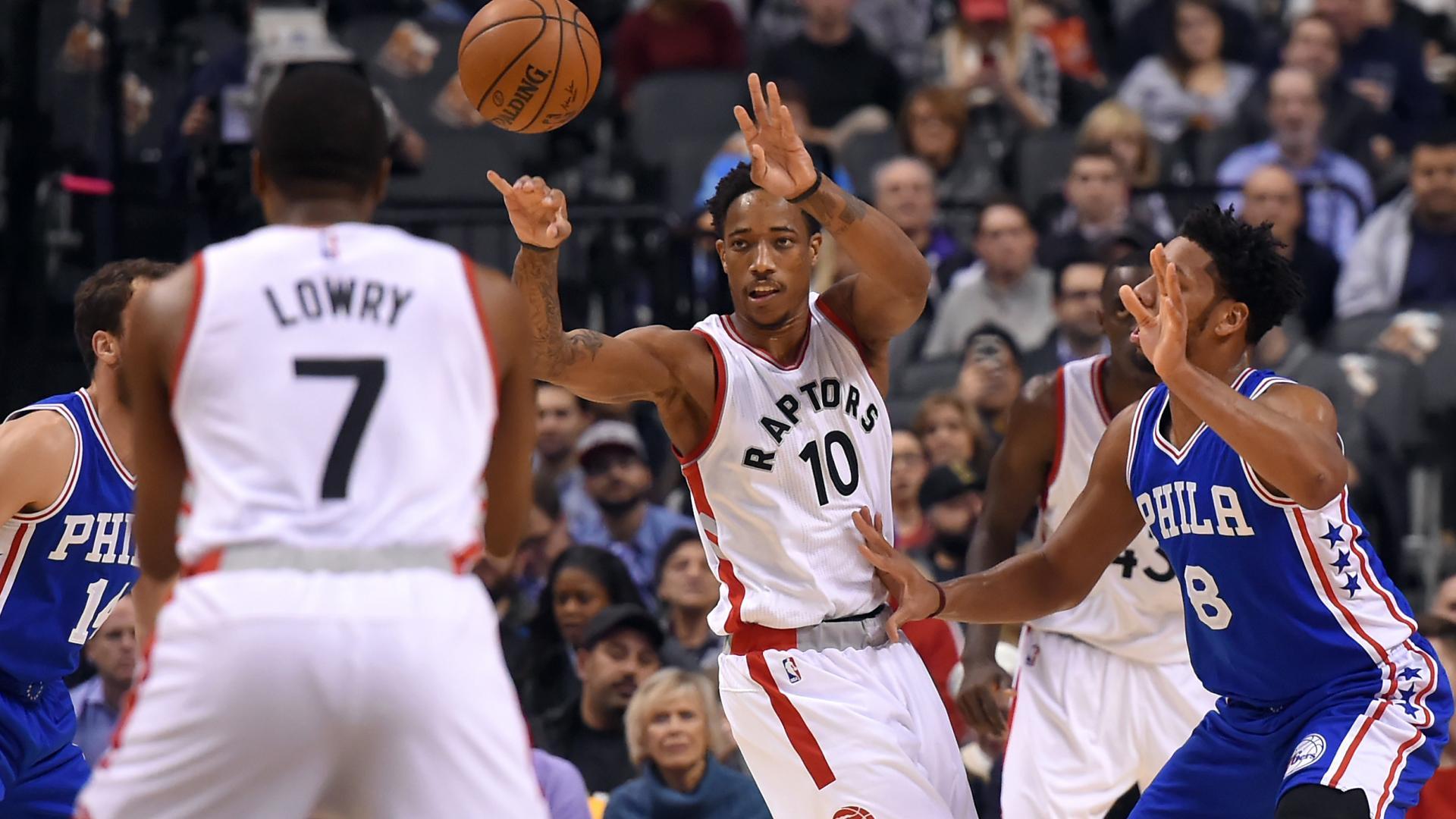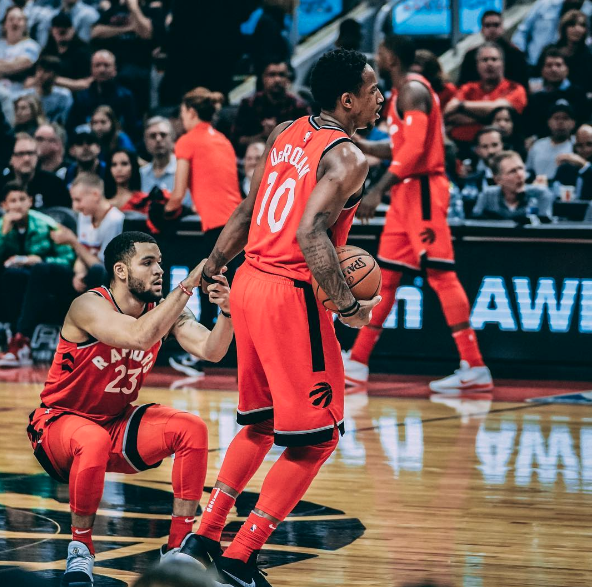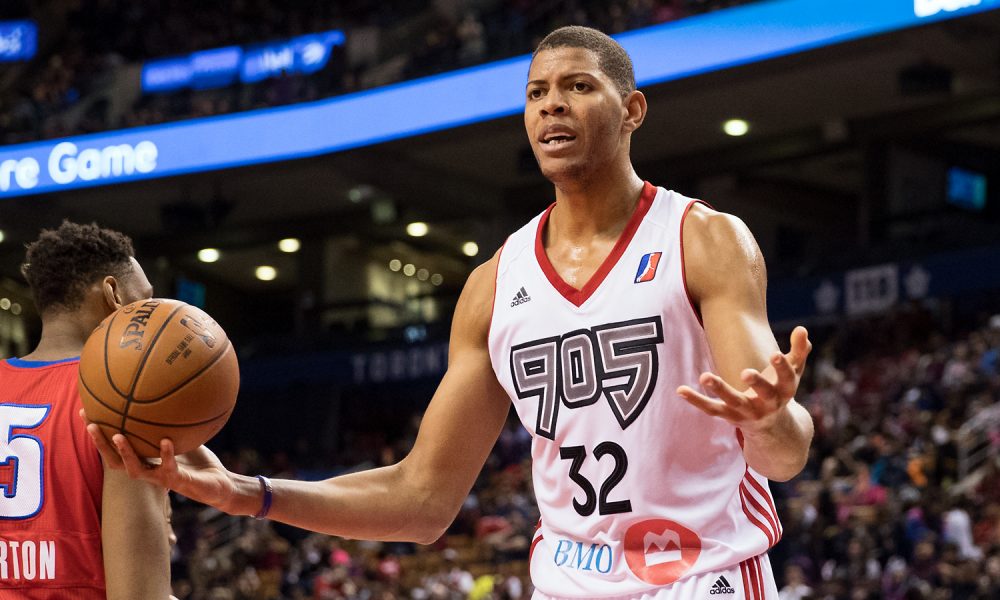Change starts from the top. DeMar DeRozan knows this. DeMar DeRozan’s season so far has been a study in Morpheus’ mind-bending position on change in this world (and the lack thereof):
On the surface level, DeRozan has not altered some important foundations to his game. I should be clear that this is a good thing, as DeRozan’s 2016-17 season was one for the ages. Per Ben Falk of Cleaning the Glass, many of his metrics remain remarkably similar:
| Usage Rate (% of team) | Assist Rate (% of team) | Shots in Midrange (% of his shot attempts) | Shots from 3 (% of his shot attempts) | |
| 2016-17 | 35.53 (100) | 20.5 (95) | 72 (100) | 7 (0) |
| 2017-18 | 32.1 (98) | 18.7 (91) | 71 (100) | 10 (1) |
The numbers in brackets are DeRozan’s percentile rank for his position. So like last season, DeRozan uses a huge percentage of his team’s possessions when he is on the floor either by passing (at which he is incredible for his position) or shooting. When he does shoot, he leads the league in percentage of shot attempts from the midrange and is bottom of the league in percentage of shot attempts from 3. There are some things in this world that will never change.
Significantly, DeRozan’s effective field goal percentage has nudged up from 47.9% last year to 50.0% this year. His shots are more efficient, in part because he is getting slightly different types of shots from the midrange. DeRozan is attacking earlier in the shot clock, before the defense can get set and begin communicating. He is shooting the ball after fewer dribbles and fewer seconds of holding it. His shooting percentages skyrocket when he holds the ball for 0-2 seconds, dribbles 0 times, and shoots early in the shot clock.
This increased aggression is well-displayed in a play in which DeRozan scored from the midrange near the end of the shot clock:
DeRozan could easily have flopped for a foul on the catch with 6 left on the clock, but instead he quickly uses the screen to drive ahead of the big coming to double team him, fading away from midrange to beat the clock and his defenders. He attacks decisively and purposefully, not leaning on or waiting for calls from the refs.
Furthermore, the percentage of DeRozan’s baskets that he hasn’t had to create for himself has also jumped from 21.8% that were assisted in 2016-17 to 28.6% in 2017-18. He is cutting harder, increasing his share of easy scores in which others do the work. Here he is streaking the lane for an easy layup in transition:
As a passer, DeRozan is expertly manipulating defenses with the leverage of his scoring ability. He was a very good passer last year, but his excellent vision was only sometimes complemented by willingness to distribute. He is more consistently willing to involve his teammates this year. In this play, he uses a Jonas Valanciunas off-ball screen to get open in the midrange, hesitates to draw a second defender to help the back-pedalling big, and then kicks out to a wide-open Kyle Lowry:
He knew where the open shot was going to be before he even took the screen from Valanciunas. Here’s another high-level pass. DeRozan uses a weave up top to get the ball going downhill. A Lucas Nogueira screen comes from an awkward angle, and DeRozan and Bebe brilliantly read the flip at the same time. Attacking a back-pedalling big again, DeRozan slows his attack like James Harden, chopping his strides to mesmerize the defense. Joe Ingles drifts towards the middle just a few inches too far, opening a quick swing to the corner:
Heady stuff: vision complemented by a willingness to pass. He is a master at manipulating defenses subtly.
On defense, DeRozan has noticeably maintained his higher competition level from the second half of 2016-17. He is top-25 in the league in steals, at 1.6 per game (his career high for a full season is 1.2 in 2014-15). When asked about his newfound penchant for thievery, DeRozan played up his understanding of positioning: “It’s just me looking at the game…having a higher anticipation level… [I try] not to be a guy that gambles for steals…[so I] play the center field of things and [am] able to recover if [I] don’t get the steal.” DeRozan is in the 73rd percentile for his position at stealing the ball and the 89th percentile for not fouling, per Ben Falk. Translation: damn right he’s not gambling.
Critics have often pointed towards DeRozan’s inability to translate his breathtaking athleticism to the defensive end, where he has frequently been slow and flat-footed when moving laterally and recovering at shooters. He has improved at both this season. Here’s DeRozan communicating early on a switch, letting Norman Powell know about a screen, rotating well onto a Joe Ingles drive to force an early pass, and closing off the possession with a rebound:
DeRozan had an incredibly 2016-17, but he has thus far had a more well-rounded campaign this year. Casey now trusts DeRozan to anchor otherwise all-bench units, and the Trojan has responded well. The lineup of Delon Wright, DeMar DeRozan, C.J. Miles, OG Anunoby, and Jakob Poeltl has played in 6 games and dominated both ends of the floor for a net rating of +15.7. He is easing into Lowry’s traditional role of propping up the scoring punch of bench units.
DeRozan was a world-beater last year, yet he has changed his game slightly this year. While the new play-style has manifested in higher turnovers for DeRozan, you can bet that those will drop as he settles into his new role. Blake has talked a lot about DeRozan needing to find a better balance between passing and scoring, and it’s worth mentioning that all of the above passes occurred during DeRozan’s 37-point masterpiece against the Jazz. For the good of the team, DeRozan has remodelled his game again, passing like a superstar (he was very good before), and playing defense at an above-average level. Some things do change.



